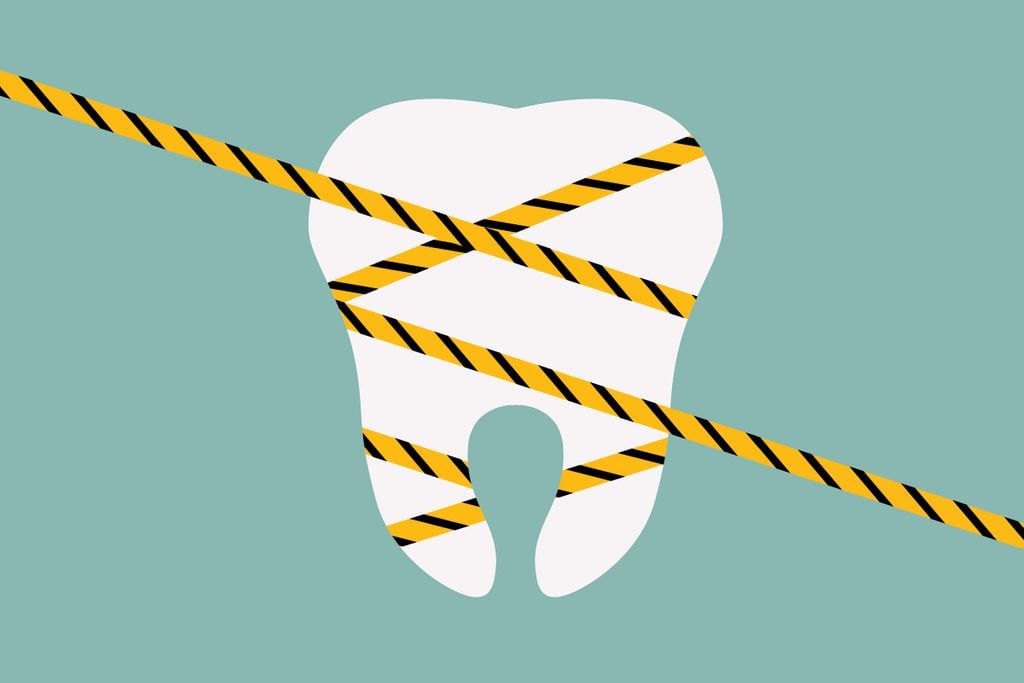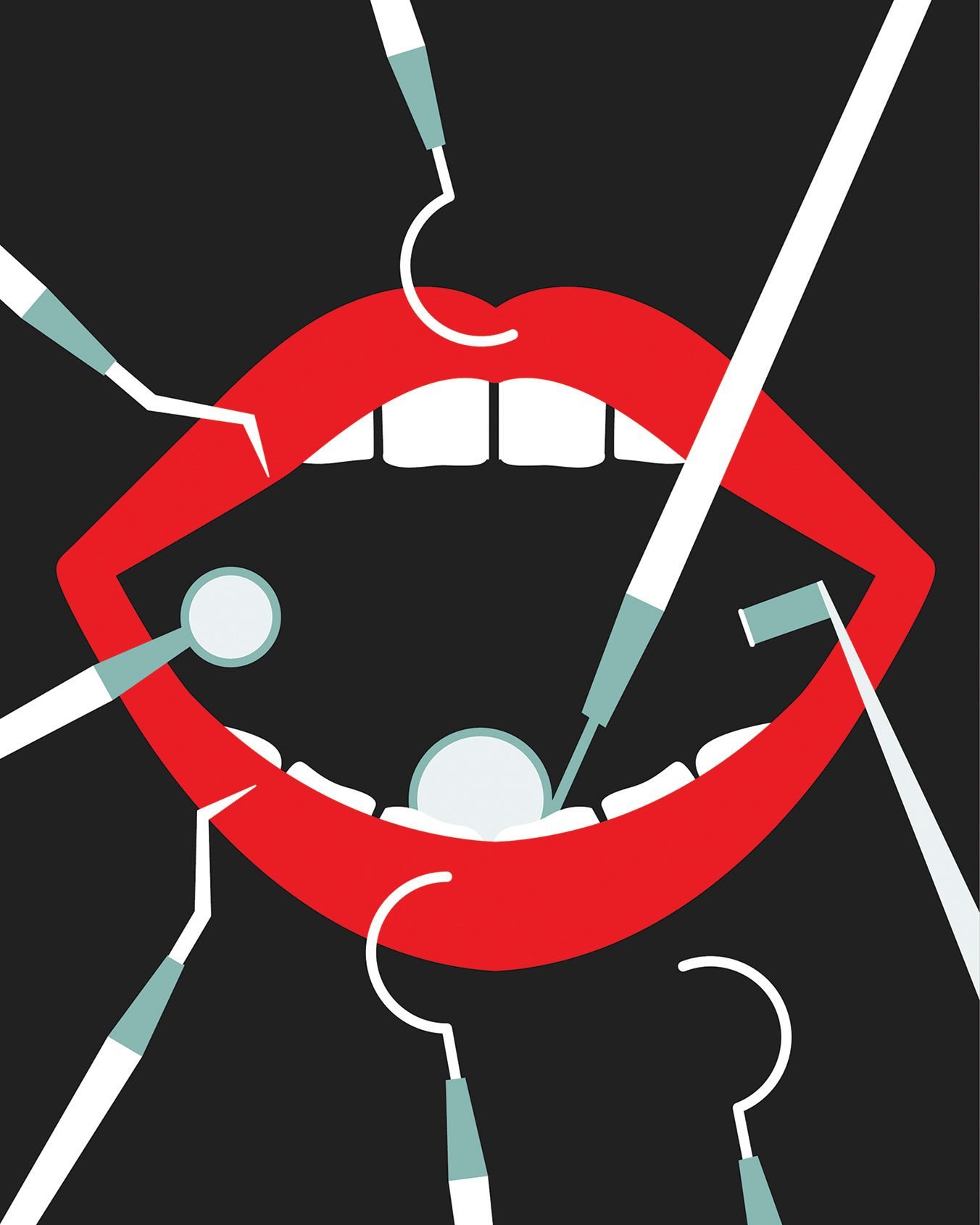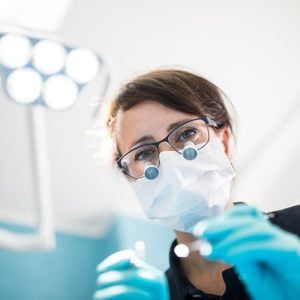Can You Trust Your Dentist?
Updated: Nov. 24, 2022

While most of the professionals who care for our teeth are reputable and honest, dentistry is less science-based and regulated than other fields. Some patients pay the price.
In the early 2000s, Terry Mitchell’s dentist retired. When one of his wisdom teeth began to ache, Mitchell, an electrician in his 50s, started looking for someone new. An acquaintance recommended John Roger Lund, DDS, whose practice was a convenient ten-minute walk from Mitchell’s home in San Jose, California.
Dr. Lund extracted the tooth with no complications. Mitchell never had any pain or new complaints, but in the space of seven years, Dr. Lund gave Mitchell nine root canals and just as many crowns. Mitchell’s insurance covered only a small portion of each procedure, so he paid about $50,000 out of pocket. He had no idea that it was unusual to undergo so many root canals. (A typical person might get one or two in a lifetime.) And he trusted Dr. Lund.
Joyce Cordi, a businesswoman in her 50s, learned of Dr. Lund through 1-800-DENTIST. When she visited him for the first time, in 1999, she had never had a cavity. Other than a small dental bridge to fix a rare congenital anomaly (she was born with one tooth trapped inside another and had them extracted), her teeth were perfectly healthy, to her knowledge. Within a year, Dr. Lund was questioning the resilience of her bridge and telling her she needed root canals and crowns.
Cordi was somewhat perplexed. Why the sudden need for so many procedures after decades of good dental health? Dr. Lund always had an answer ready. The cavity on this tooth was in the wrong position to treat with a typical filling. Her gums were receding, which had resulted in tooth decay. Clearly she had been grinding her teeth. And after all, she was getting older. As a doctor’s daughter, Cordi had been raised with an especially respectful view of medical professionals. Dr. Lund was insistent, so she agreed to the procedures. Over the course of a decade, Dr. Lund gave Cordi ten root canals and ten crowns. He also chiseled out her bridge, replacing it with two new ones that left a conspicuous gap in her front teeth. Altogether, the work cost her about $70,000.
In 2012, Dr. Lund retired. Brendon Zeidler, a young dentist looking to expand his business, bought his practice and assumed responsibility for his patients. As he met more of Dr. Lund’s former patients, he noticed a disquieting trend: Many of them had undergone extensive dental work. When Dr. Zeidler told them after routine exams or cleanings that they didn’t need any additional procedures, they tended to react with surprise and concern: Was he sure? Had he checked thoroughly? At the same time, Dr. Zeidler was making only 10 to 25 percent of Dr. Lund’s reported earnings each month.
Dr. Zeidler gathered years’ worth of records and began to scrutinize them. What he uncovered was appalling.

When you’re in the dentist’s chair, the power imbalance between practitioner and patient becomes palpable. A masked figure looms over your recumbent body, wielding power tools and sharp metal instruments, doing things to your mouth you cannot see, asking you questions you cannot properly answer, presumably judging you all the while. A cavity or receding gum line can suddenly feel like a personal failure.
When a dentist declares that there is a problem, that something must be done before it’s too late, who has the courage or expertise to disagree? When he points at spectral smudges on an X‑ray, how are we to know what’s true? In other medical contexts, such as a visit to a general practitioner or a cardiologist, we are fairly accustomed to seeking a second opinion before agreeing to surgery or an expensive regimen of pills with harsh side effects. But in the dentist’s office, the impulse is to comply, to get the whole thing over with as quickly as possible.
While the vast majority of dentists are reputable, caring professionals, the often-uneasy relationship between dentist and patient is complicated by an unfortunate reality: Common dental procedures are not always as safe, effective, or durable as we are meant to believe. As a profession, dentistry has not yet applied the same level of self-scrutiny as medicine or embraced as sweeping an emphasis on scientific evidence.
“We are isolated from the larger health system. So when evidence-based policies are being made, dentistry is often left out of the equation,” says Jane Gillette, a dentist and Republican state legislator in Bozeman, Montana, who works closely with the American Dental Association’s Center for Evidence-Based Dentistry. “We’re kind of behind the times, but increasingly we are trying to move the needle forward.”
Consider the maxim that everyone should visit the dentist twice a year for cleanings. We hear it so often, and from such a young age, that we’ve internalized it as truth. But this supposed commandment of oral health has no scientific grounding (and it was readily overruled when concern about transmitting the COVID-19 virus closed dentists’ offices last year). Scholars have traced its origins to a few potential sources, including a toothpaste ad from the 1930s and a pamphlet from 1849 that follows the travails of a man with a severe toothache. Today, an increasing number of dentists acknowledge that adults with good oral hygiene need to see a dentist only once every 12 to 16 months.
The need for many standard dental treatments is likewise not well substantiated by research. A good number of them have never been tested in meticulous clinical trials. And the data that are available are not always reassuring.
The Cochrane organization, an independent health-research firm, has conducted systematic reviews of oral-health studies since 1999. Researchers have analyzed the scientific literature, focusing on the most rigorous and well-designed studies. In some cases, their findings clearly justify certain procedures. For example, dental sealants—liquid plastics painted onto teeth like nail polish—reduce tooth decay in children and have no known risks. But most of the Cochrane reviews reach one of two disheartening conclusions: Either the available evidence fails to confirm the purported benefits of a given dental intervention or there is simply not enough research to say anything substantive one way or another.

For instance, fluoridation of drinking water seems to help reduce tooth decay in children, but there is insufficient evidence that it does the same for adults. Some data suggest that regular flossing mitigates gum disease, but there is only “weak, very unreliable” evidence that it combats plaque. As for common but invasive dental procedures: An increasing number of dentists question the tradition of prophylactic removal of wisdom teeth; little medical evidence justifies substituting tooth-colored resins for typical metal amalgams to fill cavities; and what limited data we have don’t clearly indicate whether it’s better to repair a root-canalled tooth with a crown or a filling. When Cochrane researchers tried to determine whether faulty metal fillings should be repaired or replaced, they could not find a single study that met their standards.
“The body of evidence for dentistry is disappointing,” says Derek Richards, the director of the Centre for Evidence-Based Dentistry at the University of Dundee, in Scotland. “Dentists tend to want to treat or intervene. They are more akin to surgeons than they are to physicians.”
Dr. Zeidler spent every weekend for nine months examining the charts of hundreds of patients Dr. Lund had treated in the preceding five years. In a giant Excel spreadsheet, he logged every single procedure Dr. Lund had performed so he could carry out some basic statistical analyses.
The numbers spoke for themselves. Year after year, Dr. Lund had conducted invasive, costly, and seemingly unnecessary procedures on dozens of his patients, some of whom he had been seeing for decades. Mitchell and Cordi were far from alone. Dental crowns were one of Dr. Lund’s most frequent treatments. Crowns typically last 10 to 15 years. Dr. Lund not only gave his patients superfluous crowns, but he also tended to replace them every five years—the minimum interval of time before insurance companies will cover the procedure again. More than 50 of Dr. Lund’s patients also had ludicrously high numbers of root canals: 15, 20, 24. (A typical adult mouth has 32 teeth.)
In addition to performing scores of seemingly unnecessary procedures that could result in chronic pain, medical complications, and further operations, Dr. Lund had apparently billed patients for treatments he had never administered.
Zeidler was alarmed and distressed. “We go into this profession to care for patients,” he says. “That is why we become doctors. To find, I felt, someone was doing the exact opposite of that—it was very hard, very hard to accept that someone was willing to do that.”
He knew what he had to do. He had to confront Dr. Lund and give him the chance to account for the anomalies. Even more daunting, he would have to divulge his discoveries to the patients. He would have to tell them that the man to whom they had entrusted their care for years had apparently deceived them for his own profit.

Becoming a practicing physician requires four years of medical school followed by a three-to-seven-year residency program, depending on the specialty. Dentists earn a degree in four years and, in most states, can immediately take the national board exams, get a license, and begin treating patients. (Some choose to continue training in a specialty, such as orthodontics or oral and maxillofacial surgery.) When physicians complete their residencies, they typically work for hospitals, universities, or large health-care organizations with substantial oversight, strict ethical codes, and standardized treatment regimens.
By contrast, about 80 percent of the nation’s 200,000 active dentists have individual practices, and although they are bound by a code of ethics, they typically don’t have the same level of oversight. There are dozens of journals and organizations devoted to evidence-based medicine, but only a handful devoted to evidence-based dentistry.
In the past decade, a small cohort of dentists has worked diligently to promote evidence-based dentistry, hosting workshops, publishing clinical-practice guidelines based on systematic reviews of research, and creating websites that curate useful resources. But its adoption “has been a relatively slow process,” as a 2016 commentary in the Contemporary Clinical Dentistry journal put it. Part of the problem is funding: Because dentistry is often sidelined from medicine at large, it simply does not receive as much money from the government and industry to tackle these issues.
Among other problems, dentistry’s struggle to embrace scientific inquiry has left dentists with considerable latitude to advise unnecessary procedures—whether intentionally or not. The standard euphemism for this is overtreatment. Favored procedures, many of which are elaborate and steeply priced, include root canals, the application of crowns and veneers, deep cleaning, gum grafts, fillings for “microcavities”—incipient lesions that do not require immediate treatment—and superfluous restorations and replacements, such as swapping old metal fillings for modern resin ones. As Mary Otto writes in her book, Teeth, “America’s dental-care system continues to reward those surgical procedures far more than it does prevention.”
Certainly there is a financial incentive. In the United States, the average debt of a dental-school graduate is more than $200,000. And then there’s the expense of finding an office, buying new equipment, and hiring staff to set up a private practice. A dentist’s income is entirely dependent on the number and type of procedures he or she performs; a routine cleaning and examination earns a baseline fee of only about $200.
All that said, the amount of tooth decay in many countries’ populations has declined dramatically over the past four decades, mostly thanks to fluoridated toothpaste. In the 1980s, with fewer genuine problems to treat, some practitioners turned to the newly flourishing industry of cosmetic dentistry, promoting elective procedures such as bleaching, teeth filing and straightening, gum lifts, and veneers. It’s easy to see how an unethical dentist, hoping to buoy his income, would be tempted to recommend frequent exams and proactive treatments—a small filling here, a new crown there—even when waiting and watching would be better. It’s equally easy to imagine how that behavior might escalate.
Studies that explicitly focus on overtreatment in dentistry are rare, but a recent field experiment provides some clues about its pervasiveness. A team of researchers at ETH Zurich, a Swiss university, asked a volunteer patient with three tiny, shallow cavities to visit 180 randomly selected dentists in Zurich. The Swiss Dental Guidelines state that such minor cavities do not require fillings; rather, the dentist should monitor the decay and encourage the patient to brush regularly, which can reverse the damage. Despite this, 50 of the 180 dentists suggested unnecessary treatment. Collectively, the overzealous dentists singled out 13 different teeth for drilling; each advised one to six fillings.

These results wouldn’t have surprised some Americans. In 1997, Reader’s Digest conducted its own investigation of dentists’ practices. Writer William Ecenbarger visited 50 dentists in 28 states and received prescriptions ranging from a single crown to a full-mouth reconstruction, with the price tag starting at about $500 and going up to nearly $30,000. His conclusion: “Dentistry is a stunningly inexact science.” To read more about William’s story, go here.
Dr. Zeidler confronted Dr. Lund about his discoveries in several face-to-face meetings and decided shortly thereafter to take legal action. (Repeated attempts were made to contact Dr. Lund and his lawyer for this story, but neither responded.)
One by one, Dr. Zeidler began to write, call, or sit down with patients, explaining what he had uncovered. They were shocked and angry.
“A lot of them felt, How can I be so stupid? Or, Why didn’t I go elsewhere?” Dr. Zeidler says. “But this is not about intellect. It’s about betrayal of trust.”
In October 2013, Dr. Zeidler sued Dr. Lund for misrepresenting his practice and breaching their contract. In the lawsuit, Dr. Zeidler and his lawyers argued that Dr. Lund’s reported practice income of $729,000 to $988,000 a year was “a result of fraudulent billing activity, billing for treatment that was unnecessary, and billing for treatment which was never performed.” The suit was settled for a confidential amount. From 2014 to 2017, ten of Dr. Lund’s former patients, including Mitchell and Cordi, sued him for a mix of fraud, deceit, battery, financial elder abuse, and dental malpractice. They collectively reached a nearly $3 million settlement, paid out by Dr. Lund’s insurance company. (Dr. Lund did not admit to any wrongdoing.)
Dr. Lund was arrested in May 2016 and released on $250,000 bail. The Santa Clara County district attorney’s office is prosecuting a criminal case against him based on 26 counts of insurance fraud. At his arraignment, he said he was innocent of all charges; the trial is expected to take place later this year. The Dental Board of California is seeking to revoke or suspend his license, which is currently expired.
Many of Dr. Lund’s former patients worry about their future health. One of Mitchell’s root canals has already failed: The tooth fractured, and an infection developed. Cordi’s new dentist says her X-rays resemble those of someone who had reconstructive facial surgery following a car crash. Because Dr. Lund installed her new dental bridges improperly, one of her teeth is continually damaged by everyday chewing. “It hurts like hell,” she says. She has to wear a mouth guard every night.
Worst of all, she says, “He damaged the trust I need to have in the people who take care of me. He damaged my trust in mankind. That’s an unforgivable crime.”
